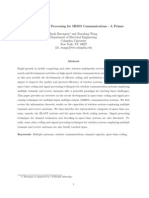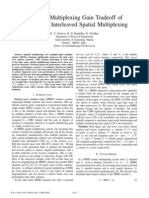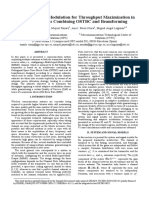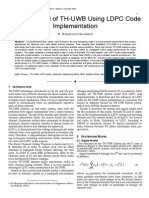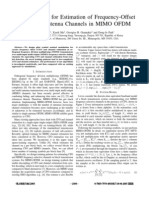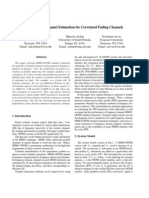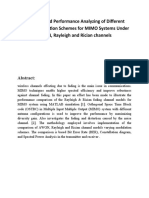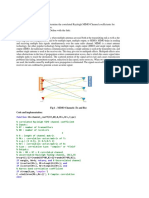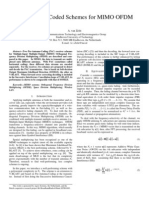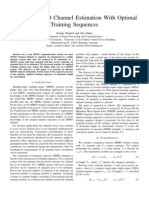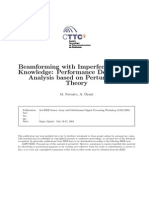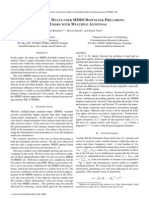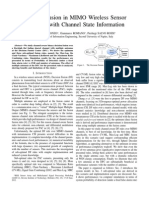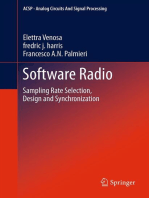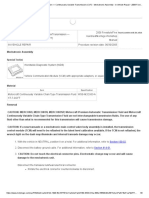Professional Documents
Culture Documents
Enhanced Mobile Digital Video Broadcasting With Distributed Space-Time Coding
Enhanced Mobile Digital Video Broadcasting With Distributed Space-Time Coding
Uploaded by
abyss2000Original Description:
Original Title
Copyright
Available Formats
Share this document
Did you find this document useful?
Is this content inappropriate?
Report this DocumentCopyright:
Available Formats
Enhanced Mobile Digital Video Broadcasting With Distributed Space-Time Coding
Enhanced Mobile Digital Video Broadcasting With Distributed Space-Time Coding
Uploaded by
abyss2000Copyright:
Available Formats
Enhanced Mobile Digital Video Broadcasting with
Distributed Space-Time Coding
Ming Liu, Matthieu Crussi` ere, Maryline H elard, Jean-Francois H elard
Universit e Europ eenne de Bretagne (UEB)
INSA, IETR, UMR 6164, F-35708, Rennes, France
Email: {ming.liu; matthieu.crussiere; maryline.helard; jean-francois.helard}@insa-rennes.fr
Youssef Nasser
American University of Beirut
ECE Department, Beirut, Lebanon
Email: yn10@aub.edu.lb
AbstractThis paper investigates the distributed space-time
(ST) coding proposals for the future Digital Video Broadcasting
Next Generation Handheld (DVB-NGH) standard. We rst the-
oretically show that the distributed MIMO scheme is the best
broadcasting scenario in terms of channel capacity. Consequently
we evaluate the performance of several ST coding proposals
for DVB-NGH with practical system specications and channel
conditions. Simulation results demonstrate that the 3D code is
the best ST coding solution for broadcasting in the distributed
MIMO scenario.
I. INTRODUCTION
In order to meet the ever-increasing demand of mobile digi-
tal television (DTV) broadcasting, the Digital Video Broadcast-
ing (DVB) consortium started the standardization process of
the Next Generation Handheld specication (DVB-NGH) [?]
at the beginning of 2010. DVB-NGH will be nalized in the
rst half of 2012 to acquire the leading position in the future
mobile DTV market.
Owing to the future extension frame (FEF) dened in DVB-
second generation Terrestrial (DVB-T2) [?], DVB-NGH can
inherit many state-of-the-art transmission technologies such as
low density parity check (LDPC) code, orthogonal frequency-
division multiplexing (OFDM) and, more importantly, can
share the hardware as well as the frequency channel in a time
division manner with the xed DTV services. Being different
from DVB-T2, the new DVB-NGH is expected to be able to
deliver DTV services to the battery-powered mobile receivers
efciently, exibly and reliably. To fulll these requirements,
DVB-NGH incorporates the multiple-input, multiple-output
(MIMO) technique aiming at achieving higher throughput and
improving the robustness of the mobile reception in severe
broadcasting scenarios.
This paper investigates the application of MIMO technique
in the DTV broadcasting. We rst show that the distributed
MIMO scheme is the best choice among typical broadcast-
ing scenarios from the channel capacity perspective. With
this knowledge, we consequently evaluate several distributed
space-time (ST) coding proposals for DVB-NGH. Simulations
with DVB-NGH specications in realistic channel conditions
demonstrate that the 3D code [?] is the best ST coding scheme.
The research results presented in this paper belong to the
framework of the European CELTIC project ENGINES [?]
which is an active contributor to the standardization of DVB-
NGH.
In the sequel, the variables with boldface represent the
vectors or matrices; A
T
, A
and A
H
denotes the transpose,
conjugate and Hermitian transpose of the matrix A; a
is the
conjugate of the complex number a; E{} is the expectation
value.
II. BROADCASTING SCENARIOS AND CHANNEL
CAPACITIES
A. MIMO-OFDM Transmission Model
Consider a MIMO transmission with N
T
transmit and N
R
receive antennas, the channel impulse response of an L-tap
multipath channel can be written as:
G =
L1
l=0
H
l
(n l), (1)
where
H
l
=
_
_
h11(l) h
1N
T
(l)
.
.
.
.
.
.
.
.
.
h
N
R
1
(l) h
N
R
N
T
(l)
_
_
N
R
N
T
(2)
is an N
R
N
T
complex-valued matrix representing the lth
channel tap of the MIMO channel, where the (p, q)th element
h
p,q
(l) is the lth tap of the (p, q)th channel link from the qth
transmit antenna to the pth receive antenna.
When the cyclic prex (CP) is long enough compared with
the maximum channel delay spread, the OFDM transmission
can be seen as parallel transmissions over a number of at-
fading sub-channels. The channel frequency response for the
kth subcarrier of the MIMO-OFDM transmission can be
written as an N
R
N
T
matrix:
H[k] =
L1
l=0
H
l
e
i
2
N
kl
=
_
_
H11(k) H
1N
T
(k)
.
.
.
.
.
.
.
.
.
H
N
R
1
(k) H
N
R
N
T
(k)
_
_
, (3)
where the (p, q)th element H
pq
(k) =
L1
l=0
h
p,q
(l)e
i
2
N
kl
is
the frequency response of kth subcarrier through the (p, q)th
channel link in an N-subcarrier OFDM system. The MIMO-
OFDM transmission can be expressed by:
Y = HX+W, (4)
where X is the frequency domain transmitted signal, Y is
the received signal and W is the additive white Gaussian
noise (AWGN). X is written in stacked vector forms X =
[X
1
(0), . . . X
N
T
(0), . . . X
1
(N 1), . . . X
N
T
(N 1)]
T
. The
same arrangement is applied to Y and Was well. The stacked
channel matrix is:
H =
_
H[0] 0
.
.
.
.
.
.
.
.
.
0 H[N1]
_
NN
R
NN
T
, (5)
where X
q
(k) denotes the signal transmitted on the qth antenna
and the kth subcarrier. Similar notations are applied to Y
p
(k)s
and W
p
(k)s. W satises E{WW
H
} =
2
n
I
NN
R
.
B. Broadcasting Scenarios and Capacity Evaluation
1) Single Frequency Network: The single frequency net-
work (SFN) [?] is a spectrally efcient implementation of the
broadcasting network. The same signal is sent from several
different transmitters at the same time on the same carrier fre-
quency. In the following discussion, we focus on the scenario
where SFN involves two transmitters as illustrated by Fig. ??.
Owing to SFN, the coverage of the broadcasting is expended
without the need of additional broadcasting bands.
Considering that the same signal is transmitted from the
two transmitters as shown in Fig. ??, the received signal (4)
can be written as:
Y = (
_
(1)
H
(1)
+
_
(2)
H
(2)
)
. .
H
SFN
X+W, (6)
where H
(1)
, H
(2)
, Y, X and W follow the denitions in
(5) with N
R
= N
T
= 1 while H
(1)
and H
(2)
represent the
channel matrices associated with the two different transmitters,
respectively.
(1)
and
(2)
are power scale factors of the two
channels representing the propagation path losses.
Examining (6), the SFN transmission can be seen as a SISO
transmission with an equivalent channel matrix H
SFN
. Keeping
the overall transmission power as P, the covariance matrix of
the transmitted signal is = (P/2N)I
N
. The ergodic capacity
of SFN channel is therefore:
C
SFN
= E
H
_
1
N
log
2
_
det
_
I
N
+
1
2
n
H
SFN
H
H
SFN
_
_
_
=E
H
_
1
N
N1
k=0
log
2
_
1+
2
_
(1)
|H
(1)
(k)|
2
+
(2)
|H
(2)
(k)|
2
_
_
_
, (7)
where = P/(N
2
n
). The same notations are applied in the
following two scenarios.
2) MIMO in Single Cell: Another broadcasting scenario is
the implementation of multiple transmit and receive antennas
within the same cell. It yields the classical MIMO transmission
in the single cell. Exploring one additional dimensionspace
domain, MIMO transmission can greatly increase the through-
put of the system, namely acquiring multiplexing gain. On the
other hand, it can also be used to enhance the reliability of
the transmission exploiting diversity gain. A properly designed
MIMO transmission scheme can achieve multiplexing gain
or diversity gain or a trade-off between them [?]. A simple
example of MIMO transmission within a single cell with two
transmit and two receive antennas is shown in Fig. ??.
In the broadcasting scenario, the channel is unknown at the
transmitter but known (by pilot-assisted channel estimation)
at the receiver. Supposing that the transmitted signal X
q
(k)s
are independent Gaussian variables, for a given the overall
transmission power P, the mutual information is maximized
by transmitting signal with equal power, i.e. = E{XX
H
} =
(P/NN
T
)I
NN
T
. Ignoring the spectral efciency loss due to
CP, the ergodic capacity of the MIMO-OFDM channel can be
expressed as [?]:
C = E
H
_
1
N
log
2
_
det
_
I
NN
R
+
1
2
n
HH
H
_
_
_
=E
H
_
1
N
N1
k=0
log
2
_
det
_
I
N
R
+
N
T
H[k]H[k]
H
_
_
_
. (8)
3) Distributed MIMO: Besides the ST coding among the
antennas of the same transmission sites, the ST coding can
also be applied among the antennas of adjacent transmission
sites, which yields the distributed MIMO transmission. In
the following discussion, we focus on the distributed MIMO
scheme with two transmission sites as illustrated in Fig. ??. We
assume that each site is equipped with N
T
transmit antennas.
The distributed MIMO channel is composed of two bunches
of uncorrelated N
T
N
R
MIMO channels denoted by H
(1)
and H
(2)
. The received signal can be written as:
Y = [H
(1)
H
(2)
]
. .
H
_
(1)
0
0
(2)
_
. .
_
X
(1)
X
(2)
_
. .
X
+W, (9)
where X
(1)
and X
(2)
are the signal transmitted from each
transmission site, respectively.
(j)
=
(j)
I
NN
T
(j = 1, 2)
are the power scale matrices representing different propagation
path losses associated to the two transmission sites.
The ergodic capacity of the distributed MIMO channel is
expressed as:
C= E
H
_
1
N
log
2
_
det
_
I
2NN
R
+
1
2
n
H
H
H
H
_
_
_
= E
H
_
1
N
log
2
_
det
_
I
2NN
R
+
P
2
2
n
NN
T
_
(1)
H
(1)
H
(1)H
0
0
(2)
H
(2)
H
(2)H
_
_
_
_
. (10)
C. Comparison
Fig. 1 compares the channel capacities of the three typical
broadcasting scenarios discussed above. This comparison aims
at showing the potential of the three broadcasting schemes in
terms of the transmission efciency. The upper limit of the
transmission efciency is provided for particular broadcasting
scheme. In other words, we evaluate how much throughput
can be attained using different transmission schemes with a
given amount of transmission power. Two transmit antennas
(one per transmission site) and one receive antenna is con-
sidered in the SFN transmission scenario. Without loss of
generality, we choose the number of receive antennas equal
to two in the MIMO scenarios. In the single cell MIMO
case, the transmission site equips two transmit antennas. In
distributed MIMO case, two transmission sites are involved
in our consideration, each having two transmit antennas. The
overall transmission power P is xed to 10 kW for all the
three transmission schemes. More precisely, for the single cell
Fig. 1. Channel capacity comparison among several broadcasting scenarios.
MIMO transmission, the transmission power of the cell is P
and the power per antenna is P/2. For the SFN and distributed
MIMO cases, the transmission power per site is P/2.
The channel is assumed to be independent and identically
distributed (i.i.d.) Rayleigh channel. That is, all the elements
H
pq
(k)s in (3) are i.i.d. complex Gaussian random variables
with distribution CN(0, 1). The pathloss model is simply
assumed to be:
P
r
= P d
m
, (11)
where P
r
is the received signal power through a propagation
distance d. It can be seen that the received power decays with
mth power of the distance d. The decaying exponent m is set
to 3.5 which is the typical value of the urban area [?]. The
distance between the two transmission sites is assumed to be
10 km in the SFN and distributed MIMO cases. The two sites
locate in the 0 km and 10 km in Fig. 1, respectively. In
fact, the selection of the distance between transmission sites
is related to the network planning [?]. Many practical factors
should be taken into account, which is beyond the scope of
this paper. Without loss of generality, in our study, the distance
is selected so that the SFN can achieve a reasonable minimum
capacity, say 1.5 bits/s/Hz, within its whole coverage.
It can be seen from Fig. 1 that the single cell MIMO
scheme achieves the highest spectral efciency in short range.
It is a reasonable results because MIMO technique can acquire
multiplexing gain over the classical SISO transmission in
high SNR region (i.e. less than 6 km). Moreover, since the
transmission site of single cell MIMO emits twice transmission
power than the distributed MIMO, the single cell MIMO
achieves higher capacity than the distributed counterpart in
a short range, namely less than 3.5 km. Yet, the distributed
MIMO scheme obtains a higher average capacity within the
whole coverage. Particularly, the distributed MIMO scheme
can effectively deliver the high throughput service with a
coverage of two SISO broadcasting cells. In addition, it can
signicantly improve the capacity at the cell edges (i.e. around
5 km). Compared with SISO SFN scheme, the distributed
MIMO scheme achieve about twice channel capacity anywhere
within the coverage. In general, the distributed MIMO scheme
is a straightforward extension and effective enhancement of
the classical SISO SFN scheme.
III. ST CODING SCHEMES WITH FOUR TRANSMIT AND
TOW RECEIVE ANTENNAS
We investigate six important distributed MIMO coding
proposals for the ongoing DVB-NGH standardization [?] in
the following sections.
A. Related work
Since last decades, it has been recognized that higher
throughput can be achieved by applying spatial multiplex-
ing [?]. The pioneer work of S. Alamouti [?] shows that
the orthogonal space-time block code (OSTBC) can extract
the spatial diversity with linear processing. However, full-rate
OSTBC only exists for two transmit antennas when com-
plex signal constellations are used. Various quasi-orthogonal
STBCs (QOSTBC) such as [?], [?], [?], [?] were proposed by
relaxing the requirement of orthogonality. These QOSTBCs
achieve different trade-offs among rate, orthogonality and
diversity. [?], [?] proposed group-wise orthogonal codes for
four-transmit-antenna cases. [?] proposed Golden code, a full
diversity, quasi-orthogonal ST code for two-transmit-antenna
cases achieving the optimal diversity-multiplexing gain trade-
off. [?] combined the merits of Alamouti and Golden codes
to obtain good performance in distributed MIMO scenarios.
More details and features of these codes are illustrated in the
following sections. The related encoding matrices are given in
a hierarchical manner to highlight the schemes for intra-cell
and inter-cell ST coding, respectively.
B. Rate one ST codes
1) Jafarkhani code: A quasi orthogonal ST code is pro-
posed by Jafarkhani in [?]. The encoding matrix is:
X
Jafarkhani
=
_
A B
B A
_
=
_
_
s1 s
2
s
3
s4
s2 s
1
s
4
s3
s3 s
4
s
1
s2
s4 s
3
s
2
s1
_
_
44
, (12)
where A and B are two successive codewords of Alamouti
code [?] representing the ST coding carried out among anten-
nas of the same site. Consequently, A and B are arranged again
in an Alamouti manner forming the ST coding among different
sites. The same way of notation is used in the presentation
hereafter.
2) L
2
code: A similar rate-one code, referred to as L
2
code, is proposed in [?]. The encoding matrix is:
X
L2
=
_
A B
H
B A
H
_
=
_
_
s1 is2 s
3
s
4
s2 s1 is
4
s
3
s3 is4 s
1
s
2
s4 s3 is
2
s
1
_
_
44
. (13)
Thanks to a modied Alamouti-like intra-cell coding, the L
2
code possesses full-diversity and non-vanishing coding gain.
3) Rate one Alamouti code: Another rate one ST code can
be formed by transmitting the same Alamouti codeword in a
SFN manner. The encoding matrix can be expressed as:
X
R1 Alamouti
=
_
A
A
_
=
_
_
s1 s
2
s2 s
1
s1 s
2
s2 s
1
_
_
22
. (14)
C. Rate two ST codes
1) 3D code: A so-called Space-Time-Space (3D) coding
is proposed in [?]. The intra-cell ST coding is chosen as
Golden code, the optimal choice for two-transmit-antenna
cases. The Alamouti scheme is selected as the inter-cell ST
coding endowing the overall ST scheme robustness in the
presence of transmission power imbalance while preserving the
efciency of Golden code. The encoding matrix of 3D code is
given in (15) (at the bottom of this page), where =
1+
5
2
,
= 1 , = 1 +i(1 ) and = 1 +i(1
).
2) Spatial Multiplexing: A simple rate two ST code is
formed by transmitting the 22 spacial multiplexing (SM) [?]
in a SFN manner:
X
SM
=
_
A
A
_
=
_
s1
s2
s1
s2
_
21
. (16)
TABLE I. SUMMARY OF DIFFERENT ST CODING SCHEMES.
Category ST scheme
Nb. of
cells
N
T
N
R
Nb. of info.
symb.
Nb. of time
solts
Intra-cell ST
coding
Inter-cell ST
coding
ST decoding
complexity
a
Classical
solutions
SISO SFN 2 2 1 1 1 SFN O(N)
MISO 2 2 1 2 2 Alamouti 21 O(N)
SIMO MRC 1 1 2 1 1 O(N)
MIMO 1 (or 2) 2 2 2 2 Alamouti () (Alamouti) O(N)
Rate
one
Jafarkhani 2 4 2 4 4 Alamouti Alamouti O(M
4
)
L
2
code 2 4 2 4 4 Alamouti-like Alamouti O(2M
2
)
Rate 1 Alamouti 2 4 2 2 2 Alamouti SFN O(M
2
)
Rate
two
3D code 2 4 2 8 4 Golden Alamouti O(M
8
)
SM 4 2 2 4 2 2 1 SM 2 2 SFN O(M
2
)
Rate 2 Alamouti 2 4 2 4 2 Alamouti SM 2 2 O(M
4
)
a
The computational complexities required by the rate one and rate two ST coding schemes are the worst case searching times for each received
symbol using sphere decoder. The searching space is associated to a given constellation size M.
TABLE II. SIMULATION PARAMETERS
Parameter Value
sampling frequency 9.14 MHz
FFT size 4096
useful subcarrier 3409
GI length 1024
time interleaver size 250K cells
channel coding 16200-length LDPC, R = 4/9
LDPC decoding message-passing algorithm with max 50 iterations
Fig. 2. Generic block diagram of DVB-NGH. The shaded blocks are the
new functionalities of DVB-NGH while others are inherited from DVB-T2.
Fig. 3. Equivalent impulse response of distributed MIMO channel.
3) Rate two Alamouti code: Another rate two ST code
can be constructed by arranging two independent Alamouti
codewords in a SM manner:
X
R2 Alamouti
=
_
A
B
_
=
_
_
s1 s
2
s2 s
1
s3 s
4
s4 s
3
_
_
42
. (17)
D. Summary of the related ST codes
The main features of involved ST coding schemes are
summarized in Table I. The receiver of the ST coding scheme
is more computationally demanding than the classical schemes
if the maximum-likelihood (ML) decoding is used. We should
note that the decoding complexity is closely related to the
diversity that can be extracted from the ST code depending on
different decoding schemes. For fairness, we consider the com-
plexity that is needed to provide maximum-likelihood (ML)
decoding performance. The decoding of rate two codes is more
complex than the rate one counterparts, while information
conveyed by the rate two codes is doubled.
IV. EVALUATION AND PERFORMANCE COMPARISON
In this section we evaluate the performance of different
ST coding schemes with the specications of the DVB-NGH
Fig. 4. Performance of rate one ST codes with QPSK in the i.i.d. Rayleigh
channel, no channel coding, no power imbalance.
Fig. 5. Performance of rate two ST codes with QPSK in the i.i.d. Rayleigh
channel, no channel coding, no power imbalance.
prole. The block diagram of the DVB-NGH simulation chain
is depicted in Fig. 2. Some important simulation parameters
are given in Table II. The modulation is selected to be QPSK
and 16QAM since the higher order constellations (such as
64QAM and 256QAM) are not the preferred options in the
mobile broadcasting scenarios. The performance of the ST
codes is evaluated in both the i.i.d. Rayleigh channel and
the novel DVB-NGH MIMO outdoor channel [?]. The DVB-
NGH MIMO channel model emulates the cross-polarized 22
MIMO transmission in UHF band, which is realistic and
includes many practical transmission and propagation factors
including multipath effect, Doppler shift, correlation among
channel links etc. This model also adapts to the distributed
MIMO scenario with the combination of two uncorrelated
DVB-NGH 2 2 MIMO channels. The channel links related
to the farther transmission site is delayed and attenuated by a
factor (power attenuation factor) reecting the effect of the
difference of propagation distances as shown in Fig. 3. The
ST decoding algorithm is sphere decoder [?] for the distributed
MIMO codes. We assume that the receiver has perfect channel
information and is perfectly synchronized.
We rst evaluate BER performance of the ST codes without
any channel coding in the i.i.d. Rayleigh channel. The perfor-
mances of rate one and rate two codes are given in Fig. 4 and
Fig. 5, respectively. Classical ST coding and diversity schemes
are also taken into account as benchmarks in the comparison.
Seen from Fig. 4, the distributed MIMO codes with rate one
performs better than the classical solutions. This advantage
is due to higher diversity obtained by the distributed MIMO
codes. It is reected by the sharper slop of the BER curves.
The L
2
code achieves the best performance among the rate one
X
3D
=
_
A B
B A
_
=
1
5
_
_
(s1+s2) (s3+s4)
(s
5
+
6
)
(s
7
+
8
)
i (s3+
s4) (s1+
s2) i
(s
7
+
8
)
(s
5
+
6
)
(s5+s6) (s7+s8)
(s
1
+
2
)
(s
3
+
4
)
i (s7+
s8) (s5+
s6) i
(s
3
+
4
)
(s
1
+
2
)
_
_
84
(15)
Fig. 6. Performance of distributed MIMO coding schemes with balanced
power, in the DVB-NGH outdoor MIMO channel with f
d
= 33.3Hz.
Fig. 7. Performance of distributed MIMO coding schemes with power
imbalance, in the DVB-NGH outdoor MIMO channel with f
d
= 33.3Hz.
codes. Concerning the rate two codes, the 3D code obtains the
highest diversity (sharpest BER slop) among all candidates as
shown in Fig. 5. We note that the rate two codes obtains twice
spectral efciency as high as the rate one counterparts with
the same constellation QPSK.
Consequently, we evaluate the post-LDPC BER perfor-
mance of ST codes with the same spectral efcient in the
DVB-NGH channel. More precisely, QPSK is used for the
rate two codes (3D code, SM and rate two Alamouti) while
16QAM is selected for the rate one codes (L
2
code, Jafarkhani
code and rate one Alamouti). It can be observed from Fig. 6
that the 3D code outperforms other distributed MIMO coding
schemes with the balanced transmission power in the realistic
simulation scenario. It acquires 0.4 dB and 1.8 dB gains over
rate two Alamouti and SM schemes and more than 2 dB gains
compared to all rate one codes.
Finally, we investigate the performance of the distributed
MIMO codes in the presence of transmission power imbalance.
This study aims at showing the performance of the ST codes
in different geographical locations. Note that we normalize
the received signal power to avoid the inuence of power loss.
The horizontal axis indicates the ratio of the signal power from
the two sites in dB. It can be seen from Fig. 7 that the rate
two Alamouti scheme does not adapt to the power imbalance
situation despite its good performance in balanced power case.
This can be explained by the fact that the information delivered
by the farther site is totally lost in a strong power imbalance
case. However, the 3D code is the most robust in the presence
of power imbalance. This can be ascribed to the robustness
of Alamouti scheme (inter-cell ST coding) in face of strong
power imbalance. In the extreme case (20 dB imbalance), the
3D code acquires 1.4 dB gain over SM scheme and more than
1.9 dB gains over other rate one ST codes.
V. CONCLUSION
In this paper, we discussed integrating MIMO technique in
the digital TV broadcasting, the key topic in the standardization
of the DVB-NGH prole. We rst analyzed three possible
broadcasting scenarios including SISO SFN, single cell MIMO
and distributed MIMO. We found out that the distributed
MIMO is the most promising solution from the prospective
of channel capacity. Consequently, we studied several ST
coding schemes that adapt to the distributed MIMO through
simulations with the real specications and the state-of-the-art
MIMO channel model of DVB-NGH. Simulation results have
shown that the 3D code achieves the best performance among
all ST coding schemes in both balanced power and power
imbalance cases. The distributed 3D code can be a promising
ST coding candidate for the future mobile broadcasting system.
ACKNOWLEDGMENT
The authors would like to thank the European CELTIC
project ENGINES for its support of this work.
You might also like
- Group 80 - CONFIGURATION DIAGRAMS - Mitsubishi Outlander III - Wiring DiagramsDocument16 pagesGroup 80 - CONFIGURATION DIAGRAMS - Mitsubishi Outlander III - Wiring DiagramsandreslionNo ratings yet
- I. Berenguer Is Supported by A Fulbright FellowshipDocument25 pagesI. Berenguer Is Supported by A Fulbright FellowshipPraveen DhawanNo ratings yet
- Low Complexity Channel Estimation For 3GPP LTE Downlink MIMO OFDM SystemsDocument4 pagesLow Complexity Channel Estimation For 3GPP LTE Downlink MIMO OFDM Systemsshantz109No ratings yet
- Diversity Multiplexing Gain Tradeoff of Co-Ordinate Interleaved Spatial MultiplexingDocument5 pagesDiversity Multiplexing Gain Tradeoff of Co-Ordinate Interleaved Spatial Multiplexingss_18No ratings yet
- Non-Coherent Multiuser Massive MIMO-OFDM With Differential ModulationDocument6 pagesNon-Coherent Multiuser Massive MIMO-OFDM With Differential ModulationKarim Abd El HamidNo ratings yet
- 01 OFDM Tutorial NisarDocument4 pages01 OFDM Tutorial NisarTarik_SuleimanNo ratings yet
- (Abdelhamid - Ladaycia, Anissa - Mokraoui) @univ-Paris13.fr, Adel - Belouchrani@enp - Edu.dz, Karim - Abed-Meraim@Document5 pages(Abdelhamid - Ladaycia, Anissa - Mokraoui) @univ-Paris13.fr, Adel - Belouchrani@enp - Edu.dz, Karim - Abed-Meraim@padmaNo ratings yet
- Structured Lattice Codes For Mimo Interference Channel: Song-Nam Hong Giuseppe CaireDocument5 pagesStructured Lattice Codes For Mimo Interference Channel: Song-Nam Hong Giuseppe CaireBakoury1No ratings yet
- Performance Analysis of A Trellis Coded Beamforming Scheme For MIMO Fading ChannelsDocument4 pagesPerformance Analysis of A Trellis Coded Beamforming Scheme For MIMO Fading ChannelsMihai ManeaNo ratings yet
- Performance Comparison of Wavelet Packet Modulation and OFDM Over Multipath Wireless Channel With Narrowband InterferenceDocument4 pagesPerformance Comparison of Wavelet Packet Modulation and OFDM Over Multipath Wireless Channel With Narrowband Interferencesachin10dulkarNo ratings yet
- Training Sequence Assisted Channel Estimation For Mimo Ofdm: Sumei Sun, Ingo Wiemer, C. K. Ho, and T. T. TjhungDocument6 pagesTraining Sequence Assisted Channel Estimation For Mimo Ofdm: Sumei Sun, Ingo Wiemer, C. K. Ho, and T. T. TjhungSandeep SunkariNo ratings yet
- A Tutorial On SISO and MIMO Channel CapacitiesDocument4 pagesA Tutorial On SISO and MIMO Channel Capacitiesmashkoor86No ratings yet
- Robust Adaptive Modulation For Throughput Maximization in MIMO Systems Combining OSTBC and BeamformingDocument5 pagesRobust Adaptive Modulation For Throughput Maximization in MIMO Systems Combining OSTBC and BeamformingMeHaK KhAliDNo ratings yet
- Riciain Channel Capacity Comparison Between (8X8) and (4x4) MIMODocument5 pagesRiciain Channel Capacity Comparison Between (8X8) and (4x4) MIMOseventhsensegroupNo ratings yet
- MIMO HSDPA Throughput Measurement Results in An Urban ScenarioDocument6 pagesMIMO HSDPA Throughput Measurement Results in An Urban ScenarioAna Sofia FernandesNo ratings yet
- Space-Time Coding and Signal Processing For MIMO CommunicationsDocument14 pagesSpace-Time Coding and Signal Processing For MIMO CommunicationsMeHaK KhAliDNo ratings yet
- A Wideband Radio Channel Model For Simulation of Chaotic Communication SystemsDocument5 pagesA Wideband Radio Channel Model For Simulation of Chaotic Communication SystemskmcbestNo ratings yet
- System Model of TH-UWB Using LDPC Code ImplementationDocument7 pagesSystem Model of TH-UWB Using LDPC Code ImplementationJournal of TelecommunicationsNo ratings yet
- MIMO-OFDM Channel Estimation For Correlated Fading Channels: TX RXDocument4 pagesMIMO-OFDM Channel Estimation For Correlated Fading Channels: TX RXNizar Ben Hadj YahiaNo ratings yet
- Hopping Pilots For Estimation of Frequency-Offset and Multi-Antenna Channels in MIMO OFDMDocument5 pagesHopping Pilots For Estimation of Frequency-Offset and Multi-Antenna Channels in MIMO OFDMSandeep SunkariNo ratings yet
- 4 MeDocument15 pages4 MeBecege AkuNo ratings yet
- Macro-Diversity Versus Micro-Diversity System Capacity With Realistic Receiver RFFE ModelDocument6 pagesMacro-Diversity Versus Micro-Diversity System Capacity With Realistic Receiver RFFE ModelHazem Tarek MahmoudNo ratings yet
- MIMO-OFDM Channel Estimation For Correlated Fading Channels: TX RXDocument4 pagesMIMO-OFDM Channel Estimation For Correlated Fading Channels: TX RXkhanziaNo ratings yet
- Survey of MMSE Channel Equalizers: University of Illinois at ChicagoDocument7 pagesSurvey of MMSE Channel Equalizers: University of Illinois at Chicagoamjc16No ratings yet
- On The Mutual Orthogonality of Millimeter-Wave Massive MIMO ChannelsDocument5 pagesOn The Mutual Orthogonality of Millimeter-Wave Massive MIMO ChannelsFakhar AbbasNo ratings yet
- CM Kaltfl 080709Document5 pagesCM Kaltfl 080709Võ Quy QuangNo ratings yet
- Layered Space-Time Codes For Wireless Communications Using Multiple Transmit AntennasDocument5 pagesLayered Space-Time Codes For Wireless Communications Using Multiple Transmit AntennasAnonymous hDKqasfNo ratings yet
- Ref 19Document11 pagesRef 19Sandeep SunkariNo ratings yet
- Channel Quality Indicator Feedback in Long Term Evolution (LTE) SystemDocument6 pagesChannel Quality Indicator Feedback in Long Term Evolution (LTE) SystemMED MOHNo ratings yet
- 1202 1552 PDFDocument16 pages1202 1552 PDFarpitmatlabNo ratings yet
- MIMO Systems and Channel Models ProposalDocument11 pagesMIMO Systems and Channel Models ProposalAhmed HwaidiNo ratings yet
- Transmission Strategies For High Throughput MIMO OFDM CommunicationDocument5 pagesTransmission Strategies For High Throughput MIMO OFDM Communicationnc02sdimNo ratings yet
- A Study of Channel Estimation Techniques Based On Pilot Arrangement in OFDM SystemsDocument9 pagesA Study of Channel Estimation Techniques Based On Pilot Arrangement in OFDM Systemscasio91281No ratings yet
- Interpolation Based MIMO CLIDocument4 pagesInterpolation Based MIMO CLIweromNo ratings yet
- Implementation of Wideband Directional Channel For UMTS Link Level SimulatorDocument8 pagesImplementation of Wideband Directional Channel For UMTS Link Level SimulatorabdelNo ratings yet
- Design of Adaptive MIMO System Using Linear Dispersion CodeDocument5 pagesDesign of Adaptive MIMO System Using Linear Dispersion CodemgheryaniNo ratings yet
- MMSE Estimation of Time-Varying Channels For DVB-T Systems With Strong Co-Channel InterferenceDocument4 pagesMMSE Estimation of Time-Varying Channels For DVB-T Systems With Strong Co-Channel InterferencebalyarNo ratings yet
- CE - OFDM Channel Estimation With Timing Offset For Satellite Plus Terrestrial Multipath ChannelsDocument5 pagesCE - OFDM Channel Estimation With Timing Offset For Satellite Plus Terrestrial Multipath ChannelsNaveen KumarNo ratings yet
- Different Transmitters and ReceiversDocument22 pagesDifferent Transmitters and ReceiversAved CNo ratings yet
- Implementation of An Acoustic Localization Algorithm For Video Camera SteeringDocument14 pagesImplementation of An Acoustic Localization Algorithm For Video Camera SteeringKumari RichaNo ratings yet
- Eigen Value Based (EBB) Beamforming Precoding Design For Downlink Capacity Improvement in Multiuser MIMO ChannelDocument7 pagesEigen Value Based (EBB) Beamforming Precoding Design For Downlink Capacity Improvement in Multiuser MIMO ChannelKrishna Ram BudhathokiNo ratings yet
- C093 PDFDocument10 pagesC093 PDFSade RinconNo ratings yet
- Icc2003 A Van ZelstDocument5 pagesIcc2003 A Van ZelstNguyen Thanh PhuongNo ratings yet
- Davide Cescato, Moritz Borgmann, Helmut Bölcskei, Jan Hansen, and Andreas BurgDocument5 pagesDavide Cescato, Moritz Borgmann, Helmut Bölcskei, Jan Hansen, and Andreas BurgKhurram ShahzadNo ratings yet
- Weikert CMCS2007 PaperDocument5 pagesWeikert CMCS2007 Paperfahmi1987No ratings yet
- W ChannelDocument14 pagesW ChannelmjrahimiNo ratings yet
- Beamforming With Imperfect Channel Knowledge Performance Degradation Analysis Based On Perturbation TheoryDocument6 pagesBeamforming With Imperfect Channel Knowledge Performance Degradation Analysis Based On Perturbation TheoryLê Dương LongNo ratings yet
- Improvement in Error Performance by Cooperation: Kamel Tourki and Luc DeneireDocument4 pagesImprovement in Error Performance by Cooperation: Kamel Tourki and Luc DeneireMazhaic MahamNo ratings yet
- TG10 2Document5 pagesTG10 2m0hmdNo ratings yet
- Complex Simulation Model of Mobile Fading Channel: Tomáš Marek, Vladimír Pšenák, Vladimír WieserDocument6 pagesComplex Simulation Model of Mobile Fading Channel: Tomáš Marek, Vladimír Pšenák, Vladimír Wiesergzb012No ratings yet
- A Channel Matching Based Hybrid Analog-Digital Strategy For Massive Multi-User MIMO Downlink SystemsDocument5 pagesA Channel Matching Based Hybrid Analog-Digital Strategy For Massive Multi-User MIMO Downlink SystemsXIn XianNo ratings yet
- BER Performance of MU-MIMO System Using Dirty Paper CodingDocument5 pagesBER Performance of MU-MIMO System Using Dirty Paper CodingInternational Journal of Electrical & Electronics EngineeringNo ratings yet
- Decision Fusion in MIMO Wireless Sensor Networks With Channel State InformationDocument4 pagesDecision Fusion in MIMO Wireless Sensor Networks With Channel State InformationHukum ChoudharyNo ratings yet
- Performance Analysis of MIMO-OFDM Systems On Nakagami-M Fading ChannelsDocument5 pagesPerformance Analysis of MIMO-OFDM Systems On Nakagami-M Fading ChannelsmnoppNo ratings yet
- Signal Detection For 3GPP LTE Downlink: Algorithm and ImplementationDocument14 pagesSignal Detection For 3GPP LTE Downlink: Algorithm and ImplementationThanh HoangNo ratings yet
- Lecture Notes-Multiple Antennas For MIMO Communications - Basic TheoryDocument48 pagesLecture Notes-Multiple Antennas For MIMO Communications - Basic TheorygowthamkurriNo ratings yet
- Software Radio: Sampling Rate Selection, Design and SynchronizationFrom EverandSoftware Radio: Sampling Rate Selection, Design and SynchronizationNo ratings yet
- Green's Function Estimates for Lattice Schrödinger Operators and ApplicationsFrom EverandGreen's Function Estimates for Lattice Schrödinger Operators and ApplicationsNo ratings yet
- Spectrum & IntDocument5 pagesSpectrum & Intabyss2000No ratings yet
- Local Loop TechnologiesDocument25 pagesLocal Loop Technologiesabyss2000No ratings yet
- NGN and QualityDocument111 pagesNGN and Qualityabyss2000No ratings yet
- MAC v. PHY: How To Relay in Cellular NetworksDocument6 pagesMAC v. PHY: How To Relay in Cellular Networksabyss2000No ratings yet
- Reduced Order ControllerDocument6 pagesReduced Order Controllerabyss2000No ratings yet
- Floor Plan Symbols Hand OutDocument3 pagesFloor Plan Symbols Hand Outabyss2000No ratings yet
- Mobile Data Off-LoadingDocument14 pagesMobile Data Off-Loadingabyss2000No ratings yet
- How To Read A Floor Plan: Full-Size Bed Twin BedDocument1 pageHow To Read A Floor Plan: Full-Size Bed Twin Bedabyss2000No ratings yet
- Adaptive Dist CodingDocument5 pagesAdaptive Dist Codingabyss2000No ratings yet
- Adaptive Randomized DSTCDocument5 pagesAdaptive Randomized DSTCabyss2000No ratings yet
- Matrix AlgebraDocument22 pagesMatrix Algebraabyss2000No ratings yet
- Euclidean DistanceDocument10 pagesEuclidean Distanceabyss2000No ratings yet
- India Super Power 2030 EnvisioningDocument105 pagesIndia Super Power 2030 EnvisioningAbhimanu SharmaNo ratings yet
- TAX-303 (Input VAT)Document8 pagesTAX-303 (Input VAT)Fella GultianoNo ratings yet
- 4014 General Directions: Cutting/Marking The PatternDocument4 pages4014 General Directions: Cutting/Marking The PatterndidomessiNo ratings yet
- ThreatStream DatasheetDocument2 pagesThreatStream DatasheetMohammed El RhamdaniNo ratings yet
- Research Progress On Chemical Constituents of ZingDocument22 pagesResearch Progress On Chemical Constituents of ZingAnisah Rahmah YulianiNo ratings yet
- Iwata Airbrush CleaningDocument4 pagesIwata Airbrush CleaningNahum LopezNo ratings yet
- Ebook Using Financial Accounting Information The Alternative To Debits and Credits PDF Full Chapter PDFDocument67 pagesEbook Using Financial Accounting Information The Alternative To Debits and Credits PDF Full Chapter PDFjohn.gallardo475100% (35)
- E-Diff Bible v1 - 1aDocument21 pagesE-Diff Bible v1 - 1aMath43No ratings yet
- Frankfurt Academy Quarterly (Spring 2014 Issue) : Financing InnovationDocument30 pagesFrankfurt Academy Quarterly (Spring 2014 Issue) : Financing InnovationFrankfurt QuarterlyNo ratings yet
- OpenVPN Feature On Yealink IP PhonesDocument28 pagesOpenVPN Feature On Yealink IP PhonesJulio GuarnizNo ratings yet
- The First Seven Years by Bernard MalmudDocument5 pagesThe First Seven Years by Bernard MalmudSaad AhmadNo ratings yet
- Study On Comparative Analysis of Icici Bank and HDFC Bank Mutual Fund SchemesDocument8 pagesStudy On Comparative Analysis of Icici Bank and HDFC Bank Mutual Fund SchemesRaja DasNo ratings yet
- Mathematics in Nature in Application of BiologyDocument4 pagesMathematics in Nature in Application of BiologyAntoni Boyd Montejo AlicanteNo ratings yet
- Sikap Grade 10Document6 pagesSikap Grade 10Jeraldine LabadlabadNo ratings yet
- ILyte C Operators Manual R4Document98 pagesILyte C Operators Manual R4Amr Habashi100% (1)
- NCP (Fatigue)Document3 pagesNCP (Fatigue)Edrick SilvaNo ratings yet
- Abutment Design Example PDFDocument17 pagesAbutment Design Example PDFEng Venance Masanja100% (1)
- Familiar Metaphorical Expressions: The Penguin Guide To Plain EnglishDocument1 pageFamiliar Metaphorical Expressions: The Penguin Guide To Plain EnglishIliasNo ratings yet
- Elements of FictionDocument4 pagesElements of FictionLailanie Lagnason DumangiaNo ratings yet
- Notes Magnetic EffectDocument9 pagesNotes Magnetic EffectanandsahuNo ratings yet
- BikesDocument109 pagesBikesKanika GuptaNo ratings yet
- S P I C e J e T Q U e S T I o N SDocument43 pagesS P I C e J e T Q U e S T I o N SDharavGosaliaNo ratings yet
- 12 Reasons Why Bearings FailDocument1 page12 Reasons Why Bearings FailPhillip HowarthNo ratings yet
- SECTION 307-01A Automatic TransaxleTransmission - Continuously Variable Transmission (CVT)Document9 pagesSECTION 307-01A Automatic TransaxleTransmission - Continuously Variable Transmission (CVT)Eduardo González HidalgoNo ratings yet
- Step 1 230s - Step 2 273 Write-Up - Step2Document2 pagesStep 1 230s - Step 2 273 Write-Up - Step2lashaNo ratings yet
- Unified Payments Interface (UPI)Document5 pagesUnified Payments Interface (UPI)ANUPAM SINGHNo ratings yet
- Lesson Plan in Chem 2 - Acid BaseDocument3 pagesLesson Plan in Chem 2 - Acid BaseJennette Belliot100% (5)
- Shadgoswami'sDocument9 pagesShadgoswami'ssahil zeleNo ratings yet
- Merneptah: Merneptah or Merenptah (Reigned July or August 1213 BC - MayDocument4 pagesMerneptah: Merneptah or Merenptah (Reigned July or August 1213 BC - Maysmart123ifyNo ratings yet

